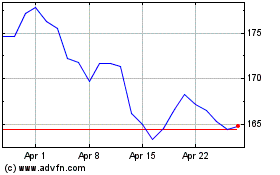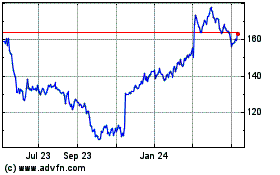Retailer's upgrades at U.S. stores attract shoppers' attention;
low gas prices a boon
By Sarah Nassauer
Wal-Mart Stores Inc. is reaping the benefits of spending heavily
to improve stores and draw shoppers, a sign that retailers need to
work hard to lure customers in an era of fast-changing shopping
behavior.
Wal-Mart, previously the poster child of staid retailers,
reported strong second-quarter results on Thursday, with sales at
established stores up for the eighth consecutive quarter and more
shoppers visiting for the seventh period in a row.
The report followed weak sales from rival Target Corp. and mixed
results from other U.S. chains. Analysts said Americans are willing
to shop, but favor stores that offer a deal, slick service or an
experience that is difficult to pitch online, such as buying bulky
lumber or fresh produce.
This week home-improvement chain Home Depot Inc. reported a 4.7%
jump in sales at established stores for its latest quarter, while
TJX Cos., the parent of T.J. Maxx, HomeGoods and other off-price
chains, posted a 4% increase. However, many apparel retailers and
department stores have reported lower foot traffic and falling
sales.
Target Chief Executive Brian Cornell said patchy consumer
spending was to blame. Macy's Inc.'s executives pointed to
encroaching competition from online retailers. It plans to close
100 stores, or 14% of its physical store base, later this fiscal
year.
A strong job market, wage gains and low gasoline prices are
boosting household budgets. But retailers touting clothes,
electronics and household staples from physical stores are
struggling to adjust to other changes in consumer behavior.
Americans are being asked to spend more on health care as costs
rise, and are choosing to spend more on services such as travel and
entertainment. And online retailers, mainly Amazon.com Inc., are
gobbling up more spending. In the first seven months of the year,
sales at nonstore retailers -- a category that includes Amazon --
rose 10% from the year-earlier period, according to the U.S.
Commerce Department, while department stores and electronics
outlets posted declines.
Wal-Mart has poured billions recently into making its U.S.
stores more efficient and pleasant, boosting employee wages and
improving e-commerce operations as it tries to fend off Amazon and
keep shoppers happy to roam its 3,500 giant U.S. Supercenters for
paper towels or milk.
"With transitions like this you tend to gain first with existing
customers," said Wal-Mart U.S. CEO Greg Foran, on a conference call
to discuss earnings Thursday. Those customers are visiting more
often and "I think they are putting an extra item in the basket
because it's in stock or looks fresh," Mr. Foran said.
Executives attributed sales gains in the U.S. to improvements
they have made to stores, as well lower gasoline prices that left
shoppers with more money to spend. For the first time in nine
quarters, Wal-Mart's e-commerce sales rose faster than the previous
quarter. Sales were hurt by deflationary food prices, executives
said.
For the quarter ended July 31, Wal-Mart reported earnings of
$3.77 billion, or $1.21 a share, up 8.6% compared with a
year-earlier profit of $3.48 billion, or $1.08 a share.
Revenue edged up 0.5% to $120.85 billion.
On Thursday, Wal-Mart lifted its profit outlook for the fiscal
year ending in January. It also said sales at existing U.S.
Wal-Mart stores, which rose 1.6% in the fiscal second quarter,
would rise 1% to 1.5% in the third quarter. Shares in the company
rose 1.9% to $74.30 on Thursday.
Consumers are still "a little more cautious than the numbers
might indicate," said Brett Biggs, the retailer's finance chief.
"But overall, we are seeing a consumer that is acting quite
steadily."
There are also signs that struggling chains aren't being
well-run or offering anything shoppers can't buy online with
Amazon. Most of the 100 stores Macy's plans to close "are
underperformers or in weak locations" Macy's finance chief, Karen
Hoguet, told analysts last week. Target has struggled to draw
shoppers to its selection of fresh groceries, and its online sales
growth is slowing.
Wal-Mart is paying heavily to boost sales. "Unfortunately, the
price of this stability has been a multiyear erosion in margins and
profitability, " John Zolidis, retail analyst at the Buckingham
Research Group, wrote in a note.
Wal-Mart's operating income fell 7.2% in the latest quarter,
mostly because of investments in e-commerce and store-employee wage
increases.
Earlier this month, Wal-Mart agreed to purchase discount online
retailer Jet.com Inc. for $3.3 billion. Including the purchase and
latest results, profit could fall as much as 9% this year, compared
with an earlier prediction for a 12% drop, Mr. Biggs said in an
interview.
Write to Sarah Nassauer at sarah.nassauer@wsj.com
Corrections & Amplifications: What demand there is has been
shifting online away from traditional retailers such as Macy's,
Kohl's Corp. and Nordstrom Inc., which all reported lower quarterly
sales last week. An earlier version of this article incorrectly
stated the retailers reported lower sales this week.
(END) Dow Jones Newswires
August 19, 2016 02:48 ET (06:48 GMT)
Copyright (c) 2016 Dow Jones & Company, Inc.
Target (NYSE:TGT)
Historical Stock Chart
From Mar 2024 to Apr 2024

Target (NYSE:TGT)
Historical Stock Chart
From Apr 2023 to Apr 2024
